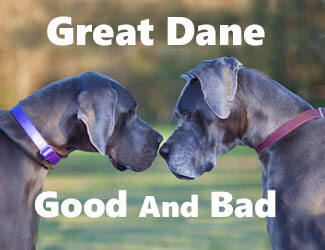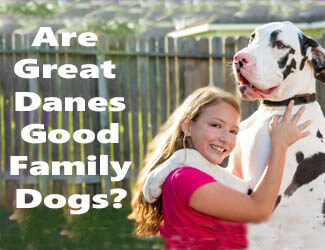What Do Great Danes Like
...and Dislike?
by Ken Alden
Great Danes are giant-breed dogs explicitly known for their massive size. Despite their intimidating stature, Great Danes are gentle, patient, and affectionate. They’re relatively easy to train and enjoy spending time with their owners.
What Do Great Danes Like?
Great Danes like many things, including car rides, exercise, long walks, affection, toys, and playing. Some Great Danes may need training and socialization to get used to cats, other dogs, boats, swimming, and water. Overall, they’re well-rounded dogs that have several interests.
Whether you currently own a Great Dane or are looking to welcome one into your family, you might have some questions about what the breed likes. Read on below to get answers to these 33 commonly asked questions about Great Danes.
Pro-tip: Ever try lifting a Great Dane? Their weight can hurt not only your back but their joints when they hop down from cars, sofas or even your bed. To protect your back and theirs check out the best Mastiff ramps on Amazon.com now.
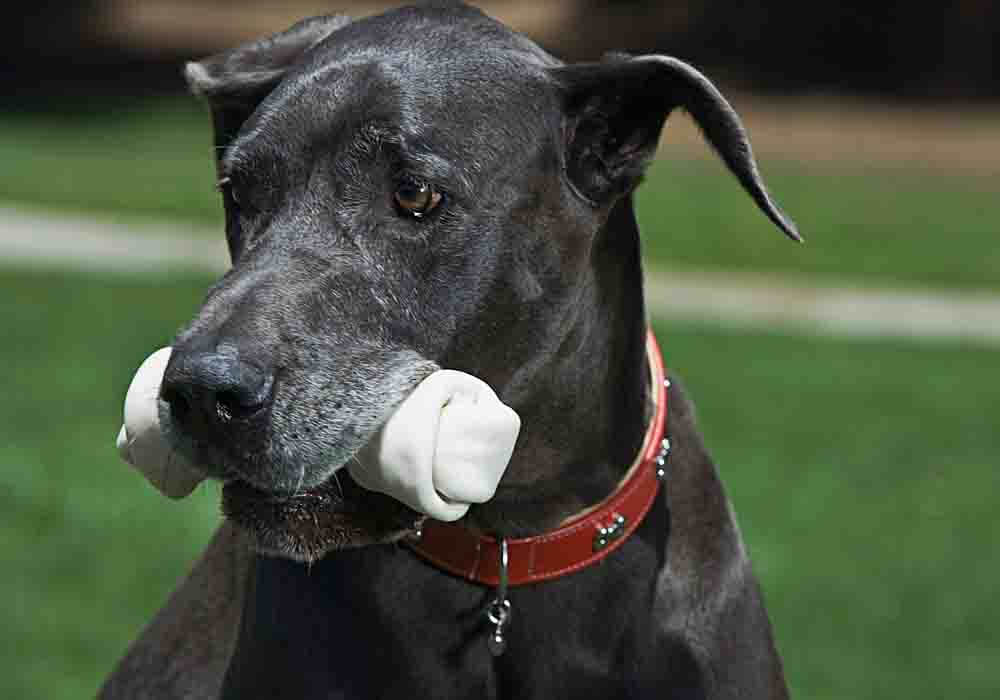
Do Great Danes Like Car Rides?
Most dogs love car rides, and Great Danes are no exception. Riding in a car with their family gives dogs a sense of adventure and lets them experience new smells, sounds, and sights. what do great danes like
Despite their large size, Great Danes don’t seem to mind sliding into the seat of a vehicle and going along for a ride. Just make sure to keep the window open so they can enjoy the open air!
Do Great Danes Like Cats?
Unlike other breeds, Great Danes don’t have a powerful prey drive. This makes them an exceptional companion for homes with cats.
Great Danes are gentle, loving, and affectionate. So with the proper training and socialization, they can be tolerant and even friendly with felines.
Do Great Danes Like Cold Weather?
Great Danes don’t have a layer of subcutaneous fat like other breeds. The lack of this fat layer means that Great Danes are more susceptible to cold temperatures. That, in combination with their short coat, means that they aren’t built for cold weather.
Do Great Danes Like Apples?
Apples are a nutritious treat for dogs, and many Great Danes enjoy eating them. These tasty fruits are high in fiber, vitamin C, and potassium.
When feeding your Great Dane apples, be sure to remove the core, stem, and seeds. Apple seeds contain amygdalin, which converts to hydrogen cyanide once digested. A few apple seeds are unlikely to cause harm, but it’s best to avoid the risk altogether.
The peel is acceptable for your canine companion to eat but wash it thoroughly beforehand. If your Great Dane refuses apples, try spreading peanut butter (be sure it doesn’t contain xylitol) on a few slices. Your Great Dane will likely scarf them down in a heartbeat!
Pro-tip: Great Dane anxiety, aggression, destructive chewing, jumping up, fearfulness, and other behaviors can be controlled with the right training program.
Here’s a great course that
addresses these issues along with many other dog training basics: Check it out now!
Do Great Danes Like Boats?
When Great Danes are introduced to boats early on, they’re likely to enjoy being out on open water — so yes, Great Danes do like boats!
With that said, their massive size could pose a problem on smaller water vessels. These mighty canines stand up to 34 inches (86 cm) at the shoulders and weigh up to 200 pounds (91 kg), and could easily put a small boat off-balance.
In addition, Great Danes tend to be clumsy creatures, especially in the first year of their life. They grow rapidly, so their bodies need time to coordinate.
Owners must train these massive canines how to behave on boats. It’s also wise to use carpets on the bottom of the boat to give them traction.
Do Great Danes Like Crates?
Many Great Danes love crates, as long as they’re crate trained from an early age. Owners of Great Danes might be opposed to crate training because of the breed’s large stature. what do great danes like
However, Great Danes benefit from crate training like any other dog! In fact, Great Danes may come to enjoy their crate, as it’s a place where they can retreat and relax.
Because Great Danes are so large, however, it’s essential to have a crate big enough to house your long-legged friend. Not to mention, these dogs are strong, so it’s important to choose a crate that will withstand his strength.
Do Great Danes Like Exercise?
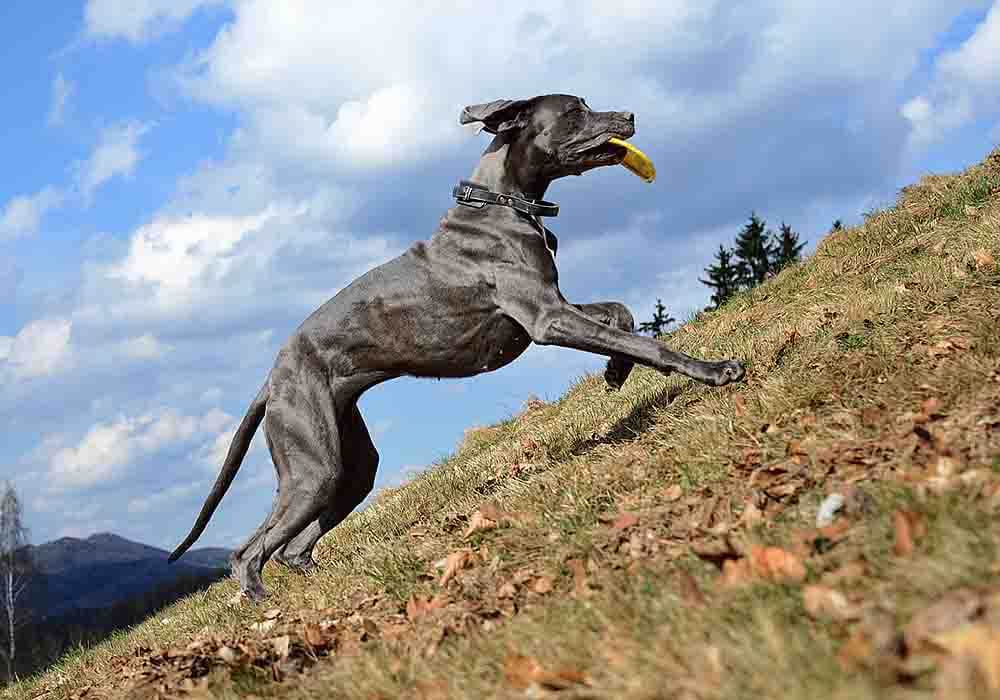
Great Danes love to exercise, especially with their family! Adult Great Danes need at least an hour of exercise every day, whereas puppies and younger Great Danes should get at least an hour and a half.
Exercise includes runs, walks, swimming, fetch, tug-of-war, and agility. A well-exercised Great Dane is a happy Great Dane!
For more on this read our helpful article dedicated to Great Dane exercise.
Do Great Danes Like Feet?
Great Danes are big, but that won’t stop them from lying on your feet! From the time they’re puppies, these dogs follow their mother, usually walking alongside her feet.
Great Danes may choose to lie on your feet because of their instinctual desire to be close to their pack. When your Great Dane acts as a foot warmer, it’s likely because he feels safe with you.
Do Great Danes Like Hugs?
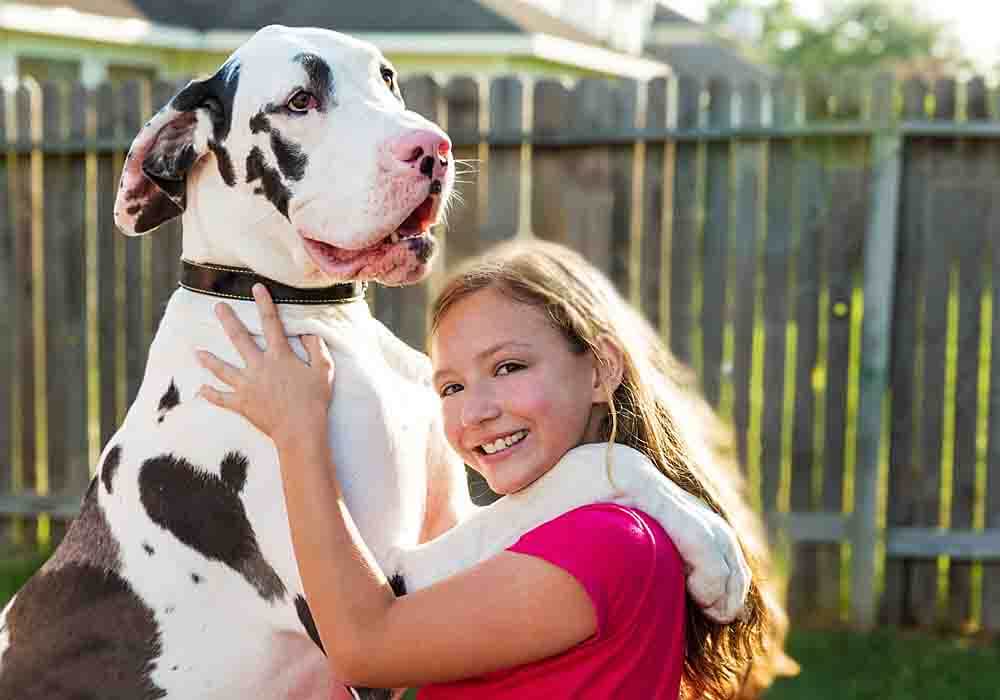
In short, some do, and some don’t. Great Danes are highly affectionate dogs.
However, hugging isn’t always the best way to show affection, and some behavioral experts say that hugging a dog can induce anxiety. If your Great Dane shows any aversion to a loving embrace, it’s best to stick to gentle pets and belly rubs.
On the other hand, some sources say that hugging depends on the dog. Dogs are individuals, after all, each with their own personality, likes, and dislikes.
Great Danes tend to be more affectionate than other breeds and might be more inclined to enjoy hugs. Some dogs show reduced anxiety during an embrace; there are even “hugging vests” made for dogs that have anxiety.
Pro-tip: Great Dane's (and their owners) love dog crates…and for good reasons. Crates keep dogs from mischief while you're away, are perfect for house training, for traveling by car, and provide the dog a place to de-stress. Check out the best Mastiff crates on Amazon.com now.
Do Great Danes Like Kongs?
There’s a reason that Kong toys are so popular. Dogs are fascinated by Kongs, Great Danes included. These toys give dogs a way to satisfy their instinctive need to chase and chew. what do great danes like
The toys are durable, so they’re strong enough to withstand the strength of a giant-breed Great Dane. In addition, these toys allow owners to hide treats inside, giving your Great Dane a “job” to do, which will stimulate him mentally.
Do Great Danes Like Long Walks?
Great Danes love to go on long walks with their owners!
These large dogs have high levels of stamina and can walk for miles. A daily walk for an hour each time is sufficient enough for a Great Dane.
Be sure to keep your eye on your Great Dane during any exercise and look for any signs of fatigue. Don’t over-exercise your furry friend, especially puppies, since their bones and joints are still actively growing.
Do Great Danes Like Other Dogs?
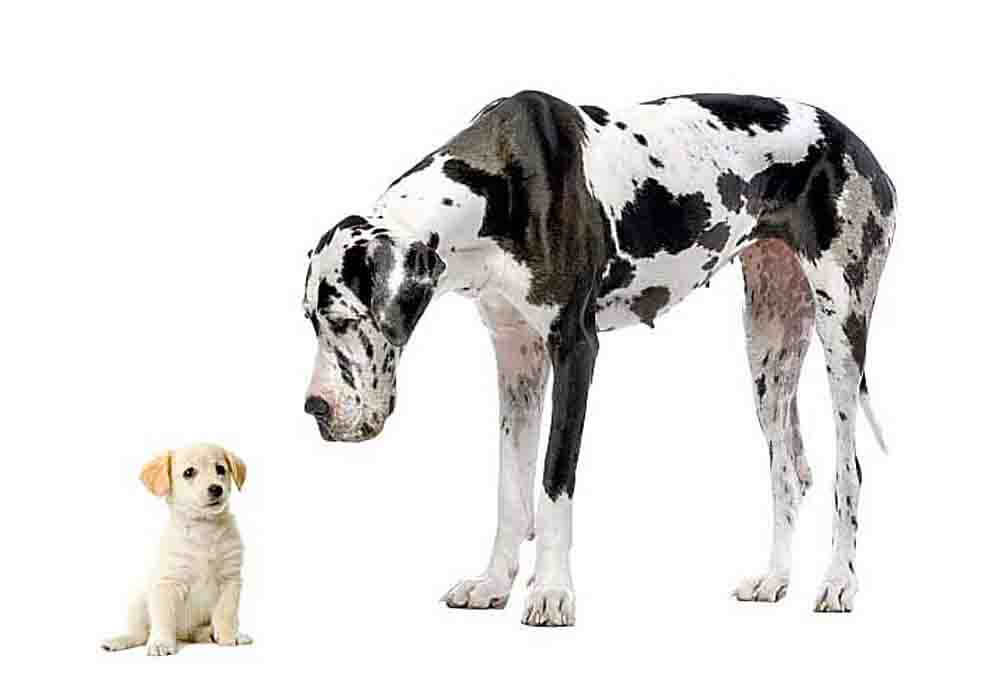
In general, Great Danes get along well with other dogs. These massive canines are fairly tolerant and are often very friendly with other dogs.
They must be socialized from a young age, however.
In some circumstances, a Great Dane may show situational aggression. In that case, be sure to address the issue immediately with an obedience trainer.
Some Great Danes may try to assert dominance over other dogs, and because of their towering size, this could lead to unintentional injury. Keep this in mind when introducing your Great Dane to other dogs.
Do Great Danes Like Small Spaces?
Because of their large size, there’s a misconception that Great Danes are averse to small spaces. That’s not true; Great Danes actually respond well to apartment living!
They require less exercise than other large breeds, and because of their calm, gentle nature, they will dwell in an apartment just fine. As long as they’re getting daily exercise, apartment living is acceptable. What do Great Danes like?
However, some Great Danes may become uncomfortable in tiny spaces, such as a bathtub. In those situations, you could opt for bathing your Great Dane outside in a small pool or taking him to a self-serve dog wash station.
Do Great Danes Like Snow?
As mentioned earlier in this post, Great Danes don’t do well in the cold. Cold temperatures alone are enough to make him feel uncomfortable. Add snow to the equation, and the situation becomes potentially dangerous.
Great Danes are very sensitive to cold and should be adequately protected in the snow. Dog socks, sweaters, jackets, or coats are excellent options for cold, snowy days. Keep trips outdoors short, and make sure to supervise your Great Dane when he’s outside on a cold day.
Do Great Danes Like Tennis Balls?
Tennis balls are a common toy for dogs, and Great Danes tend to enjoy them. Unfortunately, a Great Dane’s strength means that he could easily split a tennis ball.
Once a tennis ball breaks, it can block your dog’s airway, leading to a potentially fatal medical emergency. If he swallows part of the ball, it can cause a dangerous bowel obstruction.
It’s better to stick with hard bones, bully sticks, or durable chew toys. I recommend the Kong Extreme Dog Toy from Amazon, as it is made of tough, durable rubber and is difficult to destroy.
Do Great Danes Like the Cold?
Throughout this post, we’ve discussed Great Danes and their susceptibility to cold temperatures. They don’t like the cold, nor do they tolerate it well. So, what if your home stays cold?
During the summer, many homeowners keep their homes cool with air conditioning systems. In that case, Great Dane owners should make sure that their dog has access to warm blankets and pillows. In addition, he should have a warm place to sleep that’s off of the floor, especially if you have wood or tile.
If all else fails, he probably wouldn’t mind sleeping in your bed with you!
Do Great Danes Like the Heat?
Great Danes don’t like the cold, but they seem to enjoy the heat more than other breeds! A Great Dane’s large ears cool them off on hot days, and their short coat stops them from overheating.
Sweltering temperatures, however, are dangerous to any dog, including Great Danes. They have trouble regulating their body temperature, so take precautions to keep them safe:
- Keep him hydrated.
- Move him to a cool area if he shows signs of fatigue, excessive panting, pale gums, or dry tongue.
- Don’t overexert your Great Dane on hot days.
As long as you’re responsible and pay attention to your Great Dane, a little fun on a warm day shouldn’t cause any problems.
Learn more about how well Great Danes fare in hot or cold weather from this helpful article of ours on this topic.
Do Great Danes Like the Water?
While some Great Danes have an aversion to water, others love splashing around in cool streams or running through yard sprinklers. Introducing a Great Dane to water from a young age is the best way to encourage a healthy relationship with it.
You can train a Great Dane to get used to water by starting in shallow pools. As he gets comfortable, give him lots of treats and affection to positively reinforce his behavior.
Do Great Danes Like To Chew?
Chewing is a natural canine instinct, and Great Danes are no stranger to getting their jaws on things around the house. Great Danes love to chew!
When they’re young, Great Danes are more likely to chew, as they experience pain from teething. This behavior shouldn’t be punished but should be redirected. Give your Great Dane plenty of designated chew toys and chewy treats like bully sticks.
Do Great Danes Like To Cuddle?
Yes, many Great Danes love to cuddle! These large creatures are often referred to as “gentle giants” because of their friendly temperament and affectionate nature. Despite their massive size, Great Danes may try to sit on your lap or lie on your feet, just to be close.
Do Great Danes Like To Dig?
Great Danes aren’t avid diggers, but that doesn’t mean that they won’t dig a hole or two from time to time! Digging is a natural canine instinct, and because of their strength, Great Danes dig massive holes in minutes.
They might dig out of boredom, anxiety, or even dig a “den” to stay cool. If digging is a problem for your Great Dane, be sure that he is getting enough exercise and mental stimulation.
Do Great Danes Like To Hike?
A healthy Great Dane would love nothing more than to go on a hike with his human.
However, you must know the trails you’re hiking to avoid dangerous situations because of a Great Dane’s joint problems. It would also be nearly impossible to carry an injured Great Dane back to civilization if he were to fall or cut his footpads on sharp rocks.
Start with short hikes on well-known trails. Over time, build stamina with your Great Dane. Take frequent breaks and make sure that both you and your canine companion stay hydrated.
Here's even more on the Dane's exercise needs...
Do Great Danes Like To Jump?
Great Danes love to jump, but because of their size, jumping on people is dangerous. Fortunately, there are training techniques to teach a Great Dane not to jump on people.
Because Great Danes are large and athletic, they’re known to escape yards by jumping over fences. Proper training and socialization can prevent this behavior in most Great Danes.
Do Great Danes Like To Play?
Despite their imposing size, Great Danes are sweet, playful pets. They love to play and are gentle with children and other pets.
While they have the potential to be rambunctious, especially as puppies, they’re generally pretty easy to train. After a long day of playing, these gentle giants enjoy spending time lounging around with their families.
Do Great Danes Like To Run?
Great Danes were bred as hunting dogs, so it’s no surprise that these long-legged canines love to run. These dogs make great running partners, thanks to their quick speed, high energy, and stamina. Short jogs are ideal, as these Great Danes tend to have issues with their joints.
When they’re puppies, however, their rapidly growing legs may make them clumsy on their feet. Owners mustn’t overdo it when exercising a Great Dane puppy.
Do Great Danes Like To Snuggle?
Yes, Great Danes like to snuggle. A large canine snuggling up to their owner on the couch, bed, or floor is a common sight in homes with Great Danes.
These affectionate, friendly canines love to be close to their family. In fact, they don’t handle being alone very well and stick close to their family whenever possible.
Do Great Danes Like To Swim?
Great Danes are not natural swimmers. Despite this, many are willing to jump into the water and doggy paddle as best as they can. These dogs have long legs and large, powerful upper bodies, making it possible for them to keep themselves upright and move through the water.
Dogs raised in and around water tend to be more likely to jump in and enjoy it, whereas others may avoid water altogether. When encouraging a Great Dane to get into the water, be sure to supervise him.
Although they’re capable of swimming, they’re not the best at it.
What Do Great Danes Like To Eat?
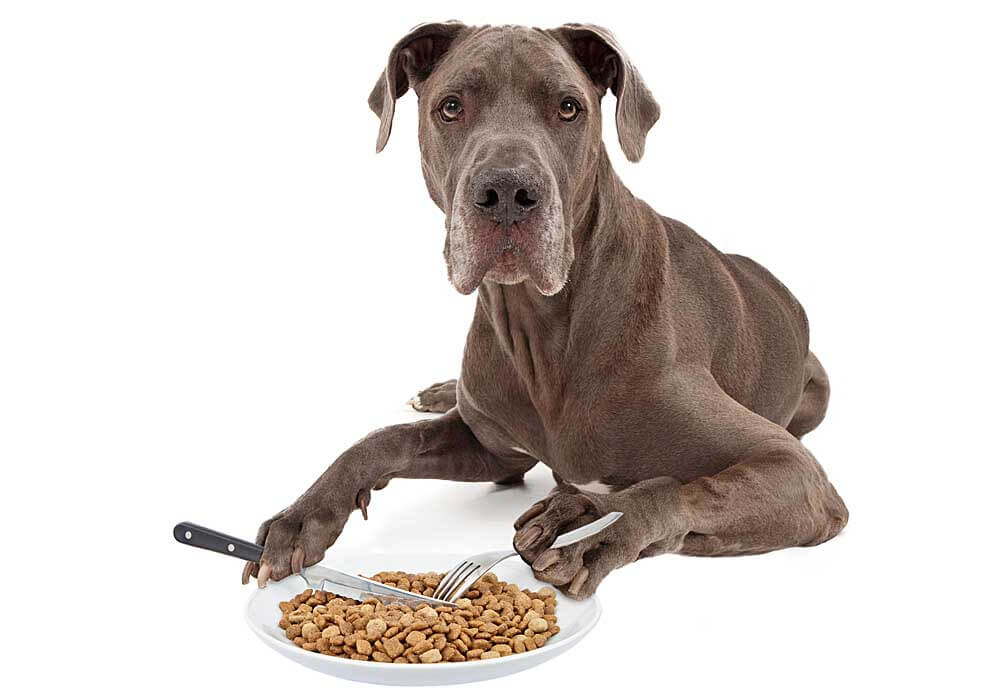
Great Danes are notoriously picky eaters, so you must choose a food that’s nutritionally valuable but also liked by your furry friend.
Many Great Danes like raw food diets. These tend to be more appetizing to dogs, as it’s closer to the diets of wild canines. For treats, Great Danes enjoy peanut butter (without xylitol—it’s toxic to dogs!), apples, bully sticks, and raw bones.
Ideal dog food for a Great Dane should contain at least five meat proteins. Because they are a fast-growing breed, they need high-quality, premium dog food (or raw food) to maintain muscle mass and proper bone growth. Protein should make up no more than 24% of the food, with fat levels between 12 and 14%.
What Do Great Danes Like To Play With?
Different Great Danes prefer different toys. Some enjoy soft, plush toys that they can cuddle up with, whereas others like to chew on rubber balls or tires.
Experiment with different varieties of dog toys to see which ones your Great Dane likes best.
If your Great Dane tends to destroy toys quickly, avoid cheap materials and stuffed toys. Instead, opt for tightly woven ropes, Kong balls, or toys made from strong, durable rubber. Always supervise your Great Dane as he plays and choose toys that are the right size to avoid choking.
What Do Great Danes Like To Sleep On?
The couch seems to be the most preferred spot for Great Danes, although many don’t mind snuggling up with their owners in bed.
No matter where your Great Dane sleeps, it’s important that the spot is soft and comfortable. Great Danes are susceptible to hip dysplasia and other joint ailments, so a hard floor is tough on their bodies.
A high-density memory foam bed is recommended and should be large enough for your Great Dane to stretch out those mile-long legs.
What Kind of Toys Do Great Danes Like?
Solid and durable toys that last for a long time are best for Great Danes. On the other hand, some prefer soft, snuggly toys. Unfortunately, the latter is less durable.
Great Danes also enjoy toys that make sounds. Rubber squeaky toys are ideal, as rubber is stronger than other materials. I recommend the VANFINE Dog Squeaky Toy as it’s made of durable, all-natural rubber and stands up to even the most aggressive chewers.
Where Do Great Danes Like To Be Pet?
Every Great Dane has its very own special “spot” where it likes to be petted. Some of the common areas include:
- Under the chin
- Back of the neck
- The base of the tail
- Stomach
- Behind the ears
Many Great Danes dislike being touched around the tail, legs, and muzzle.
Where Do Great Danes Like To Sleep?
Great Danes sleep a lot and will fall asleep anywhere they feel comfortable. That includes lying on your lap, on the floor at your feet, or outside on the grass. Some of the most popular spots for Great Danes include the sofa, rugs, and especially in bed with their owners.
What Do Great Danes Like...Final Thoughts
Large and imposing yet kind and gentle, Great Danes are exceptionally well-rounded dogs. They love many things, from simple foods like apples to going on short car rides. Sleeping in a soft bed, playing with toys, and getting (and giving) affection are some of their favorite pastimes. Above all else, Great Danes love nothing more than spending time with their owners.
Return to the top of this What Do Great Danes Like page

About the Author...
Ken Alden, a dedicated Mastiff owner for over eight years, is acclaimed for his expertise in care, grooming, and training. Read more About Me and my dog Shadow.
- Mastiff Guide Home ›
- Great Danes Dog Info ›
- What Do Great Danes Like?




